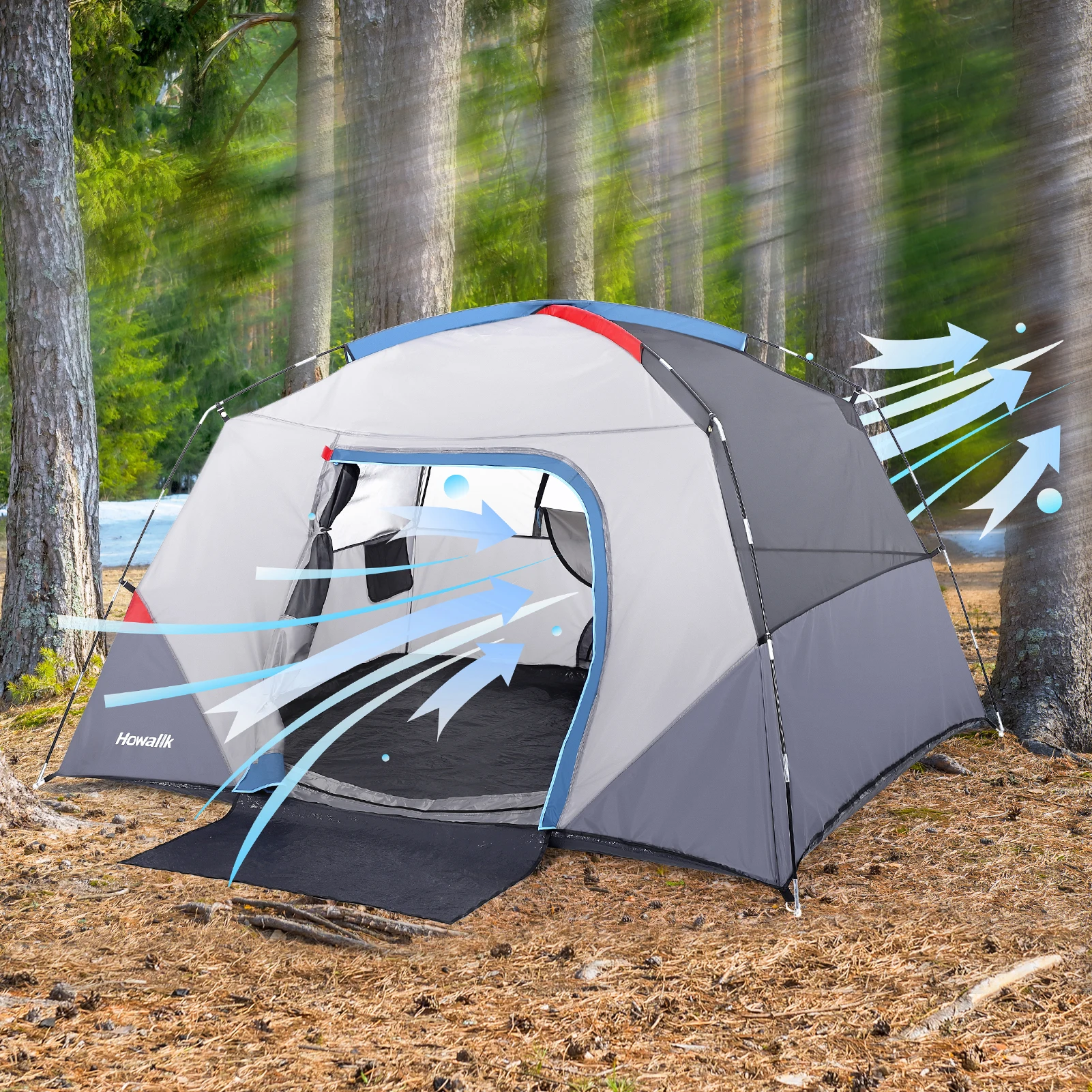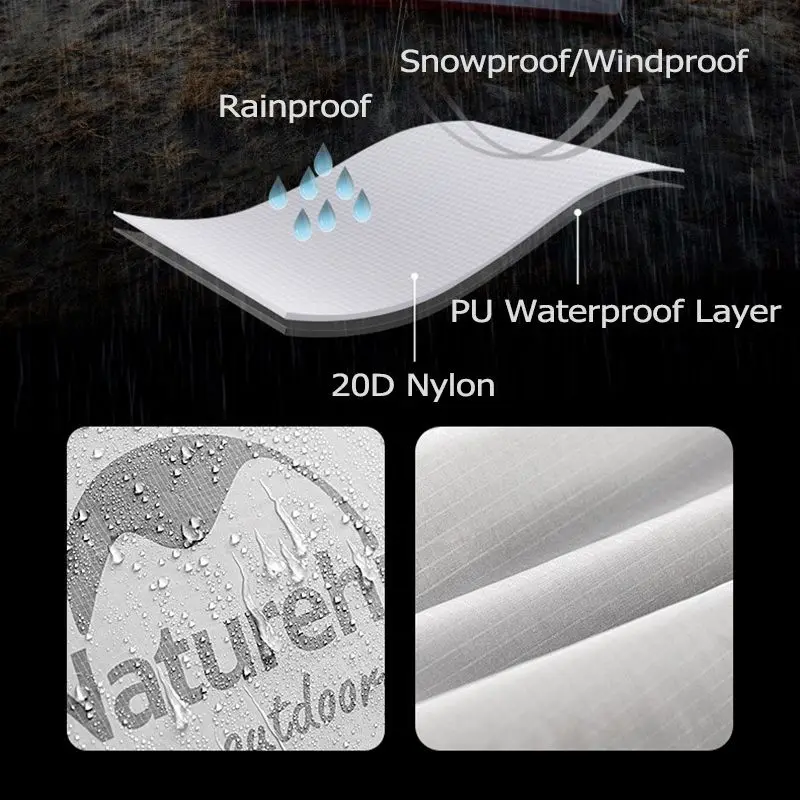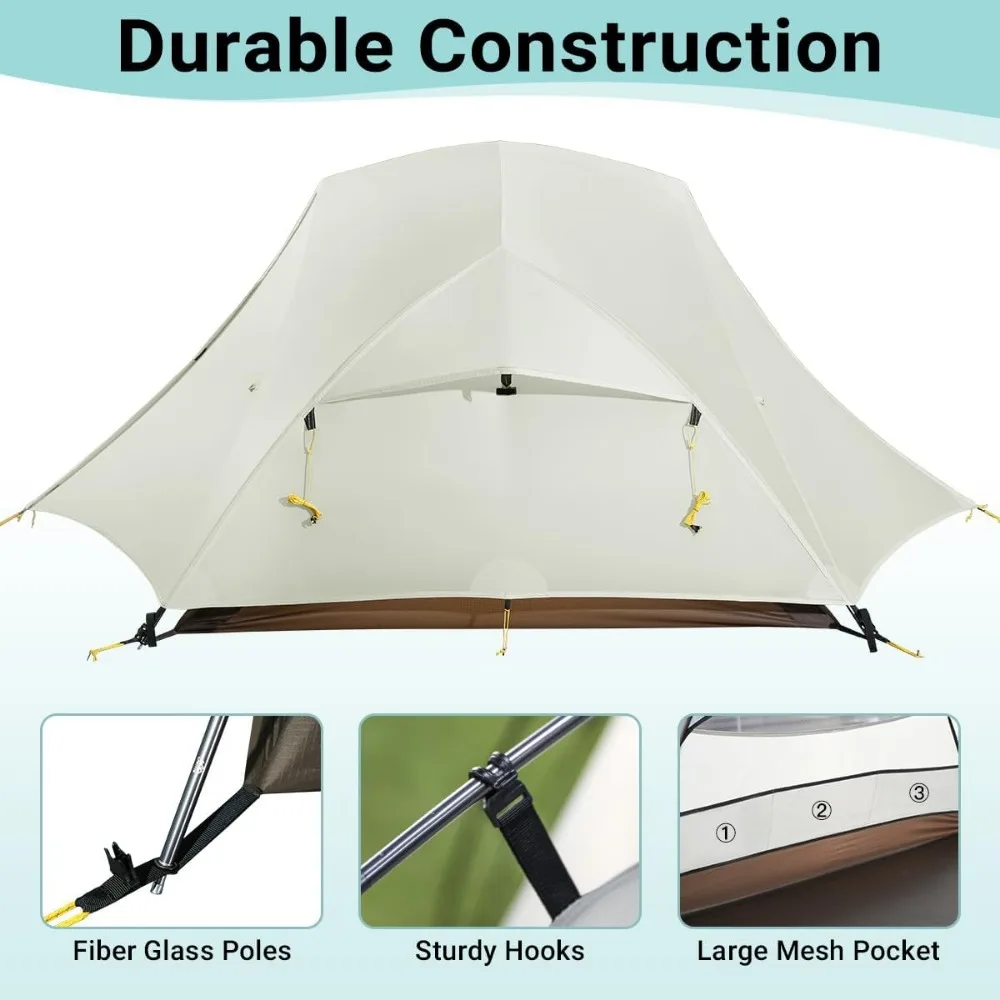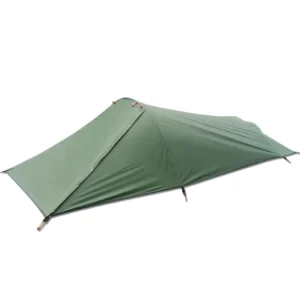The Truth About “2-Person” Tent Capacity: Understanding the Labeling Reality
When you see “2-person tent” on a label, what does it really mean? Unfortunately, most tent manufacturers determine capacity based on the absolute minimum space needed—essentially, how many sleeping bags can be crammed side-by-side with zero extra room. This approach creates a significant gap between marketing labels and actual comfort.
To put this in perspective, standard sleeping pads are 20-25 inches wide. In a typical 2-person tent with a floor width of 50-52 inches, two pads will fit… and that’s about it. No space for backpacks, changing clothes, or even rolling over comfortably.
The industry essentially operates on “survival space” rather than “comfort space.” A 2-person tent provides enough room for two people to sleep in a pinch, but rarely delivers the comfort most campers expect.
Throughout this guide, we’ll help you understand the reality behind tent sizing labels, determine what size actually works for your camping style, and make an informed decision that balances weight, space, and comfort. As experienced campers know, comprehensive compact shelters for two campers can vary dramatically in their true capacity, despite sharing the same person rating.
The question of whether a 2-person tent is actually big enough deserves careful consideration beyond marketing promises—which is exactly what we’ll explore.
When a Standard 2-Person Tent Actually Works Well for Two
Despite the general recommendation to size up, there are specific scenarios where a true 2-person tent makes practical sense:
Ultralight backpacking trips: When every ounce counts on long-distance trails, the 1-2 pound weight savings of a true 2-person tent can justify the tighter quarters. Typical ultralight 2-person tents weigh 2-3 pounds compared to 3.5-5 pounds for 3-person models.
Cozy couples: Partners who are comfortable sleeping very close together and pack minimally may find standard 2-person tents perfectly adequate.
Fair weather overnight trips: For quick trips with good weather forecasts, the cramped space becomes less problematic since you’ll primarily use the tent only for sleeping.
Adult with child: When camping with a smaller companion like a child, the standard dimensions often provide sufficient room for both sleepers.
However, even in these scenarios, compromises exist. Gear may need to stay in vestibules (if available) or outside under rain covers. Changing clothes might require taking turns or creative maneuvering. Rainy days can quickly become uncomfortable if you’re confined to the tent.
For weight-conscious adventurers, exploring quality ultralight 2-person tents can reveal impressive options that balance minimal weight with functional design. Mastering proper lightweight tent setup techniques becomes particularly important when maximizing limited space.
Why Most Couples Choose a 3-Person Tent Instead: The Comfort Advantage
When it comes to extended camping trips or even weekend getaways, most couples and pairs of friends ultimately opt for 3-person tents—and for good reason. The comfort advantages are substantial:
- Room to sit up together: Many 3-person tents allow two people to sit upright simultaneously without hunching—impossible in most 2-person designs
- Interior gear storage: Keeping backpacks, boots, and other gear inside protects them from weather and wildlife
- Easier movement: The ability to change clothes, organize gear, or simply adjust your sleeping position without disturbing your partner
- Weather resilience: Extra space becomes invaluable during extended rain when you’re confined to your tent
The weight penalty is often less significant than many assume. Quality 3-person backpacking tents typically weigh only 1-2 pounds more than their 2-person counterparts—a modest increase when split between two hikers that delivers substantially more livable space.
For those concerned about weight but still wanting comfort, exploring alternative camping shelter options for two can reveal innovative designs that maximize usable space while minimizing pack weight.
Key Decision Factors: Matching Your Tent Size to Your Camping Style
The ideal tent size varies substantially based on your camping approach and personal preferences:
Backpacking Considerations
- Weight sensitivity: Ultralight enthusiasts may accept snugger quarters to save 1-2 pounds
- Trip duration: Longer trips often justify carrying extra tent weight for greater comfort
- Elevation and terrain: More challenging routes may necessitate lighter packs (and thus smaller tents)
- Personal tolerance: Some hikers simply prefer comfort over minimum weight
Car Camping Priorities
- Maximize comfort: Without weight constraints, opt for tents with generous dimensions
- Room for luxuries: Space for cots, air mattresses, camp chairs, or even small tables
- Standing height: Many car camping tents offer full standing height for ultimate convenience
- Extreme weather protection: Larger tents with stronger pole systems for stability in harsh conditions
Personal Factors That Influence Size Requirements
- Sleeper dimensions: Taller or broader campers need more floor space
- Gear volume: Photography equipment, specialty outdoor gear, or cold-weather clothing requires additional storage
- Sleep preferences: Some people need more personal space while sleeping
- Trip circumstances: Winter camping requires more interior space for bulky gear
Specialty 2-person backpacking tents offer optimized designs for weight-conscious travelers, though they still require realistic expectations about available space.
Tent Dimension Guidelines for Two People: Beyond the Person Rating
Rather than relying on person ratings, use these specific floor area guidelines based on your camping style:
| Camping Style | Recommended Floor Area | Typical Dimensions | Comfort Level |
|---|---|---|---|
| Ultralight Backpacking | 28-35 sq ft | 84” × 48” | Minimal/Snug |
| Comfort-Oriented Backpacking | 35-45 sq ft | 90” × 54” | Moderate |
| Car Camping | 40-55+ sq ft | 96” × 60” | Spacious |
When evaluating tent specifications, pay attention to these critical measurements:
Floor dimensions and shape: Rectangular floors generally offer more usable space than tapered designs.
Peak height: Measure at the highest point—ideally at least 40+ inches for comfort.
Wall angles: Near-vertical walls dramatically increase usable living space compared to steeply sloped designs.
Vestibule size: External covered storage areas (typically 4-10 sq ft per vestibule) significantly impact overall livability.
The addition of well-designed backpacking tent vestibules can effectively double your usable storage space without adding significant weight to your pack.

Understanding the Real Impact of Tent Design on Livable Space
The architecture and design features of a tent can dramatically transform how spacious it feels, even with identical floor dimensions:
Dome vs. Cabin vs. Tunnel Designs: Dome tents offer excellent strength-to-weight ratio but have significantly sloping walls that reduce usable space. Cabin-style tents have nearly vertical walls but generally weigh more. Tunnel tents often strike a balance between interior volume and reasonable weight.
Wall angles matter enormously: A tent with more vertical walls provides substantially more usable volume than one with sharply angled walls, even with identical floor dimensions. This difference becomes most noticeable when sitting up or moving inside the tent.
Multiple doors improve livability: Two doors allow each person to enter/exit without climbing over the other—a significant convenience factor often overlooked. Each person also gets their own vestibule for gear storage.
Vestibule configuration: Larger vestibules that allow protected cooking in bad weather or secure gear storage dramatically enhance comfort, particularly on longer trips.
Understanding the fundamentals of dome tent structure can help you evaluate which architectural style best meets your specific camping needs and spatial requirements.
Practical Tips for Testing and Selecting Your Ideal Two-Person Tent
Measure your sleeping setup first: Lay out your sleeping pads side by side and measure their combined width and length. Add at least 4-6 inches of width for comfort.
Test tents in person when possible: Visit outdoor retailers and actually lie down in assembled display models. Bring your sleeping pad or ask to use a store demo pad.
Evaluate floor shape carefully: A tapered foot area might save weight but can severely restrict comfort for two sleepers.
Consider the height of the tallest user: Peak height should allow the taller person to sit upright with some clearance.
Remember gear expansion: Most campers accumulate additional gear over time. A tent that feels adequate now might feel cramped as your gear collection grows.
Calculate minimum floor area: Multiply the width of two sleeping pads plus 6 inches by the length of your pads plus 6 inches. This gives you the absolute minimum floor area for basic comfort.
Lightweight Backpacking Tent, Ultralight Backpacking Tent, Ultralight Bivy Tent
Ultralight Single Person Camping Tent with Aluminum Poles for 3-Season Backpacking Waterproof DesignPrice range: $94.88 through $326.82 Select options This product has multiple variants. The options may be chosen on the product pageLightweight Backpacking Tent, Ultralight Backpacking Tent, Waterproof Backpacking Tent
$391.05 Select options This product has multiple variants. The options may be chosen on the product pageCompact Backpacking Tent, Lightweight Backpacking Tent, Waterproof Camping Tent
$335.52 Select options This product has multiple variants. The options may be chosen on the product pageUltralight Backpacking Tent, Ultralight Dome Tent, Winter Camping Tent
Price range: $369.63 through $370.07 Select options This product has multiple variants. The options may be chosen on the product pageHeavy Duty 4 Season Tent, Ultralight Freestanding Tent, Winter Camping Tent
$3,722.66 Select options This product has multiple variants. The options may be chosen on the product pageBackpacking Tent with Vestibule, Freestanding Backpacking Tent, Lightweight Backpacking Tent
Price range: $446.89 through $447.22 Select options This product has multiple variants. The options may be chosen on the product page
When exploring options, understanding the nuances of choosing compact shelters for two will help you identify tents that maximize interior space without unnecessary bulk or weight.
Supplemental: Special Considerations for Extended Trips and Extreme Conditions
Q: Does extended bad weather change tent size requirements?
A: Absolutely. Multiple days of rain can make a marginally-sized tent unbearable as you spend more time inside. For trips with potential extended rain periods, adding 20% more floor area is a wise precaution.
Q: What about winter camping?
A: Winter gear takes substantially more space. Bulky sleeping bags, extra layers, and the need to handle gear inside the tent (since leaving items outside isn’t practical) requires at least 25-30% more interior space than summer camping.
Q: How do international trips affect tent size needs?
A: Extended trips, particularly international ones, often require extra gear. Consider medical supplies, travel documents, electronics, and contingency equipment that all need protection from the elements.
Q: What about accessibility needs?
A: Campers with mobility considerations should always opt for larger tents with more headroom and floor space to accommodate easier movement and any specialized equipment.

Understanding what makes a tent ultralight can help you evaluate which features matter most when balancing weight against comfort in challenging conditions.
Decision Framework: Your Personal Tent Size Questionnaire
To determine your ideal tent size, answer these key questions:
- What is the maximum pack weight I’m willing to carry? (Under 3 lbs per person? Under 4 lbs? Weight not a concern?)
- How much gear do I typically bring, and do I prefer to store it inside the tent?
- What’s our combined sleeping pad width plus 6 inches of comfort space?
- How important is it for both of us to sit up simultaneously?
- Do we need separate entrances to avoid disturbing each other?
- Will we frequently camp in rainy conditions where we’ll be tent-bound?
- What’s my realistic budget for this purchase?
Your answers will guide you toward the right balance of size, weight, and features. Remember that tent comfort directly impacts how much you’ll enjoy your outdoor experiences.
Final Thoughts: Investing in Comfort for Years of Adventure
Choosing the right tent size is ultimately about enhancing your outdoor experiences. While marketing labels provide a starting point, your personal needs should guide the final decision. A well-chosen tent will serve as your home away from home for hundreds of nights over many years—making the initial investment in appropriate sizing well worth it.
Many experienced campers eventually settle on the “buy once, cry once” philosophy, recognizing that spending a bit more for properly sized gear leads to greater enjoyment in the long run. With proper care, a quality tent can last 7-10 years or more, making the decision even more significant.
Remember that tent capacity ratings are merely a starting point. By considering your specific needs, camping style, and comfort preferences, you’ll select a shelter that enhances rather than detracts from your outdoor adventures—regardless of what the marketing label suggests.







